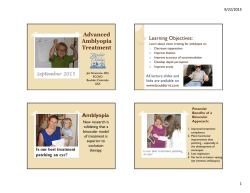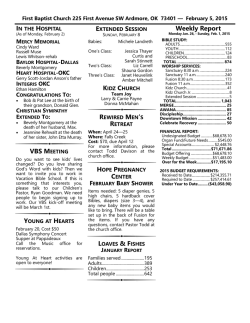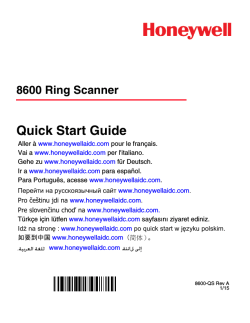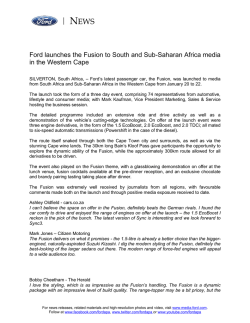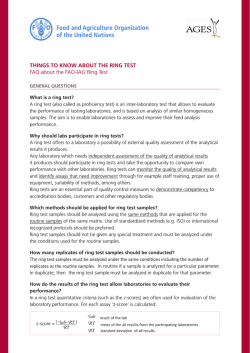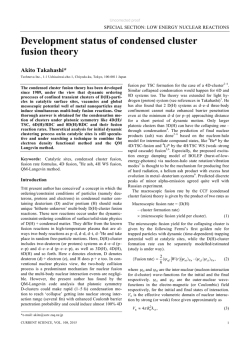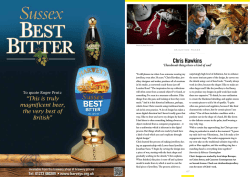
Binocular Treatment of Amblyopia
Binocular Treatment of Amblyopia Jen Simonson, OD, FCOVD www.bouldervt.com WORKSHOP LEARNING OBJECTIVES: 1) Understand the levels of sensory fusion: a) Monocular b) Monocular Fixation in a Binocular Field c) Biocular d) Binocular 2) Use activities in optometric vision therapy to develop each level: a) Equate vision skills in each eye. b) Improve monocular fixation when both eyes are open. c) Awareness of simultaneous perception when the image from each eye is located in a different space. 3) Develop Binocular Sensory Fusion: a) Simultaneous vision in the same physical space. b) Perceiving a single, fused image when each eye sees different parts of the picture. c) Peripheral fusion and float of images. d) Central fusion and stereopsis. 4) Learn techniques to eliminate suppression. 5) Use activities that create luster. 6) Teach patients to appreciate float and the location of images. 7) Integrate eye-hand coordination and visual spatial awareness with depth perception abilities. Monocular (M): Use one eye at a time Goal: Equalize vision skills in each eye Fixation Pursuit Saccades Focusing Abilities Occlusion Types Complete: solid “pirate” patch, “Band-Aid” patch, occluder, hand Translucent: light, but no detail Partial: bi-nasal or bi-temporal Blur: contact lens, Bangerter foil, tape Liquid Crystal Glasses: Amblyz, Eyetronix (M) Activities Fixation: ability of the eye to accurately aim to one point in space. Saccades: the ability to swiftly and smoothly jump accurately from one point to the next. Pursuits: the ability to smoothly and accurately follow a moving object. Accommodation: ability to focus clearly and accurately. 1|Page Monocular Fixation in a Binocular Field (MFBF) One eye sees detail and the other eye sees the background in the same space. Goal: accurate perception of details with one eye and the perception of the background with the other eye. (MFBF) Activities Hide and Seek: pom poms on felt Hide and Seek: iPad games Red- Ink Coloring activities Red/Green Cards: Sherman Cards, Perceptive Cards Button boards: Wayne, Accuvision, Sanet Vision Integrator (SVI) Biocular (Bioc) The ability to see information from both eyes, although the images are in different spaces. Goal: to improve the ability of both eyes to alternately shift focus in an un-fused situation. This will facilitate anti-suppression and prepare the patients for simultaneous perception. (Bioc) Activities Vertical Prism dissociation with ball on string, Howell card Squinchel (base-in prism) Red/Red Rock, Sherman Cards Red/Green filters placed side-by-side on reading material, crossword puzzle, hidden pictures, projector, TV etc. Spilt Vectograms with Polaroid Glasses Binocular (B) The ability of the brain to fuse information from both eyes into one image. Degrees of Binocular: 1) First Degree Fusion/ Simultaneous perception 2) Second Degree/ Flat Fusion 3) Third Degree/ Stereopsis First Degree/Simultaneous Perception Goal: To see images from each eye in the same space. First Degree Activities Luster-The perception of color information from both eyes simultaneously: white toys, colored backgrounds Flashlight activities: Press Lites Cheiroscopic tracing, Opto App Hole in Hand, Cook’s Rings Polarized or Red/Green bar readers with glasses Red Light/Red Ring Bird in Cage 2|Page Second Degree/ Flat Fusion Goal: Use both the eyes to combine common borders and to align two images received from each eye into a single perception. Second Degree Activities Mirror Superimposition Rotoscope-Major Amblyoscope Stereoscope: Morgenstern’s Visicare cards- Prefusion through Basic fusion, OPTO Computerized: VTS3 Flat fusion 1 & 2 Third Degree Fusion/ Stereopsis The ability to perceive float and localize a target using binocular depth perception. Accurate perception is of closer targets becoming smaller and further targets becoming larger SILO= small-in and large-out Third Degree Activities In-instrument Techniques: Stereoscope with Convergence/ Divergence Cards Aperture Rule Rotoscope, Amblyoscope, Synoptophore Wheatstone Cheiroscope Anaglyphic or Polarized Lens Techniques Alphabet fusion book, Keystone Cards Vectograms Tranaglyphs Free Space Fusion Techniques 3-Dot/Barrel card/Kay card Lifesaver card, Mountain card, Star cards String and Dowel, Yardstick and Pins Brock String Thumbs BI/BO Eccentric circles Prism flippers Magic Eye books Computer Fusion Techniques Vision Therapy System: Near and projected stereopsis Vision Builder: Random Dot Stereopsis, Vergence, Jump Vergence Home Therapy System: Random Dot Stereopsis Vision Tap OPTO WORKSHOP ACTIVITIES: **Additional information** http://www.bouldervt.com/news-and-events/New-NewsItem,852367 3|Page WORKSHOP ACTIVITY #1: Pom Poms and Felt (Luster, Monocular Fixation in a Binocular Field (MFBF), Tap-n-See Now, Little Bear Sees (BLACK BACKGROUND- use red lens on learning eye) WORKSHOP ACTIVITY #2: Red Ink Activities (Monocular Fixation in a Binocular Field MFBF) (WHITE BACKGROUND- use green lens on learning eye) WORKSHOP #3: Squinchel (Bi-ocular) WORKSHOP #4: Red Light/Red Ring Red/Light and Red/Ring Materials: 1. Red/green lenses 2. Large flashlight with red filter 3. Red ring targets (various sizes) 4. Black electrical tape 4|Page WORKSHOP #5: Press Lights https://youtu.be/Wgdq4Jr4MjE *or white board, red marker, laser pointer. Level 1: 1. The therapist moves the red light behind the red ring target as directed by the patient until it looks like it is centered in the red ring. 2. Repeat, moving farther away from the patient each time. 3. Continue with smaller targets: decreasing ring diameter and ring width. 4. Reduce the size of the light by placing black electrical tape over the lens. Level 2: 1. Start with the flashlight positioned so that the red light appears to be in the center of the ring. The light is then moved laterally so that it appears to be touching the inside edge of the ring. 2. Patient then attempts to move his eyes and change the position of the light so that it is re-centered in the ring. Do this several times in both horizontal directions. 3. Now move the light just outside the ring, and the patient attempts to see the light inside the ring by moving the eyes. Try to feel the difference in the posture of the eyes. Level 3: 1. The therapist keeps the light physically within the ring target. Patient is to always keep the light visually within the ring target. 2. Patient should attempt to re-center the light by actually moving his or her eyes. 3. Feel the movement of the eyes as you re-center the light from the left or from the right. Try to feel the difference in the posturing of the eyes and how the eyes feel when moving from the left compared to moving from the right. 4. Goal: See the red ring target and the red flashlight simultaneously at all times. 5. Attempt to perform with the smallest possible light and smallest possible ring size. 6. Be able to perform task at greater distances. WORKSHOP ACTIVITY #6: Mirror Super-imposition (Luster, Level 1, Level 2, Level 3) Face one chart while holding a hand mirror at a 45 degree angle on the side of your nose reflecting the other chart. Try to keep seeing the combined image by viewing both charts simultaneously 5|Page WORKSHOP ACTIVITY #7: Stereoscope (Biocular and Binocular Level 1, Level 2, Level 3) http://gerull-labs.com/stereocope-exercises 6|Page WORKSHOP ACTIVITY #8: Anaglyphic Training (MFBF, Binocular Level 3: Global Stereopsis, Contour Stereopsis, Free Space Fusion) http://gerull-labs.com/red-cyan 7|Page References Available on Request to [email protected] and posted on website page: http://www.bouldervt.com/news-and-events/New-News-Item,852367 Press Lites: http://www.oepf.org/sites/default/files/OVP1-2_article_Press_web.pdf Esotropia Manual: http://www.oepf.org/product/manual-esotropia-therapy-xet100 8|Page
© Copyright 2025
